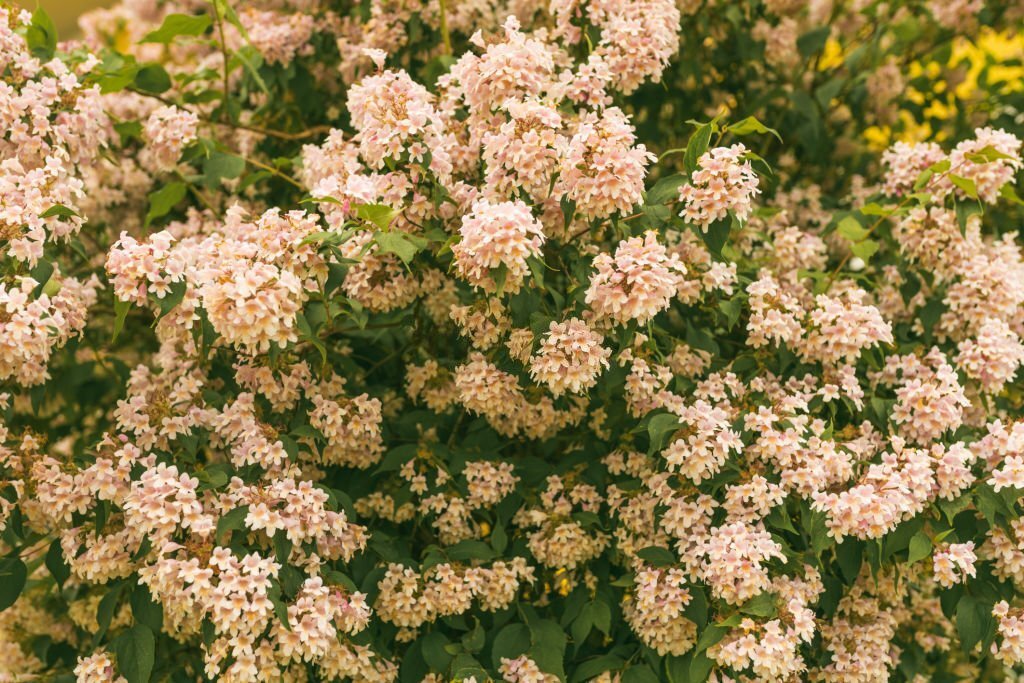
Many do not develop quickly. Some may take up to a decade before they reach the size to shade. However, this does not need to be the scenario. There are many rapidly growing trees to select from in Wisconsin.
The type of plant you can choose depends on the area’s USDA zones of cold hardiness. Wisconsin zones of planting vary from zones 3b to 5b.
There are a variety of beautiful trees in Wisconsin that are fast-growing in zones 4 and 5 like the flowering northern catalpa.
The selection is smaller in zone 3 but this list has fantastic options for those who live and reside in the zone. The most difficult are the quaking aspen and northern red oak as well as red maple.
1. American Sweet Gum (Liquidambar styraciflua)
American sweetgum is found in numerous parks as well as campuses and large yards. It is indigenous and is found throughout North America and is one of the most valuable trees in the forest.

The deciduous tree is easy to recognize due to its distinctive leaf shape. The leaves are deep shiny green in color. In autumn the leaves change color to a stunning shade of red, orange, yellow, or even purple.
It is recommended for you to grow American sweetgum in a location that receives a minimum of 6 hours of sunlight direct each day. This helps in accelerating growth and vibrant autumn color. Additionally, the deciduous tree needs ample space to grow its roots Therefore, it is best to plant it away from other trees in Wisconsin of a similar size.
American sweetgum is a great choice for acidic, loamy, humid well-drained, sandy, clay, and wet soils. It has moderate tolerance to drought. The tree is not fond of sites that are polluted.
Other common names: American storax, Hazel pin, Bilsted, Redgum, Satin-walnut, Star-leaved gum Alligator wood Sweetgum
Growing Zones: 5 – 9
The Average Size At maturity: 60 – 70 feet with the spreading of up to 45 feet
2. American Sycamore (Platanus occidentalis)
The deciduous American Sycamore is among the biggest trees found in North America. The sycamore tree symbolizes longevity as well as protection, resilience, and strength for all tree lovers.

Due to its huge dimensions due to its massive size, due to its massive size, the American Sycamore is an ideal focal tree in your garden or on the landscape. It is tough and intolerant of pollution, you can find these trees growing in urban areas across the world’s temperate zones. The tough tree is able to withstand road salt.
American Sycamore is an easy tree to establish. It thrives in full sun, however, it is able to thrive in partial shade. The sturdy tree thrives in any soil and can be tolerant of wet places. When it is established, the tree will perform perfectly in drought conditions.
Other names that are commonly used: American planetree, Western plane, Occidental plane Buttonwood, Water beech
Growing Zones: 4 – 9
The average size at Mature: 40 – 100 feet tall, with the spread of 40 – 70 feet
3. Dawn Redwood (Metasequoia glyptostroboides)
Dawn redwood is among the fastest trees in Wisconsin landscapers. However, it’s only hardy in the southern regions of the state, as well as the region that runs along Lake Michigan. It can grow up to nearly 4 feet every year.
These ancient tree roots have been in existence since the time of dinosaurs. Its leaves are feathery, which adds a touch of elegantness to the surroundings. Its leaves appear bright and green and change to into reddish-brown or orange-brown in autumn. As a deciduous conifer, it produces round 1/2 – 1-inch cones.
Dawn redwood is simple to plant and transplant. It is a fan of full sun and moist well-drained soils. It is also a great choice in loamy, acidic, sandy, wet, or clay soils. The tree is tolerant of water and drought.
This rugged and ancient tree doesn’t require the most care. Select the best location for it because it can grow more than 80 feet in height within just a few years.
Growing Zones: 5 – 8
Average Size Mature: 70 – 100 feet tall, with an average spread of 25 feet
4. Eastern Cottonwood (Populus deltoides)
Eastern cottonwood can be described as a popular tree that is found east of the Rocky Mountains. If you live in a moist area or want to plant trees near a lake or stream This is the tree for you. This tree could grow as high as 8 feet each year in moist conditions.
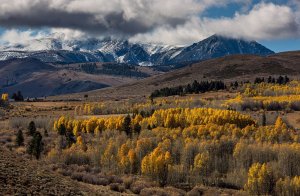
Females release the fluffy white seed material. Some complain the tiny seeds block windows as well as AC units. They also protect swimming pools.
Eastern cottonwood doesn’t require any care. It thrives in full sun and is the most effective way to guarantee beautiful autumn leaves. It likes moist soils, however, with regular watering, it can be able to thrive in soils that are dry. In the beginning, it will require approximately the equivalent of 10gallons per every inch of the tree’s diameter.
The main drawback to this tree is its shaky branches. They can fall when they are in cold or windy weather. The best method to avoid this is to do a good job of pruning. To ensure safe pruning it is recommended to consult a professional arborist who is certified.
Additional Common Names for it: Necklace poplar
Growing Zones: 2 – 9
Average Size At the Age of Mature: 50 – 80 feet tall with a similar spread
Flowering Season: Spring
5. Hackberry (Celtis occidentalis)
Hackberry is a tree that grows quickly that every landscaper in Wisconsin can plant. It’s cold-hardy to the coldest areas of Wisconsin.
If you decide to plant a hackberry plant there aren’t many issues. It is known for its ability to be “one tough tree,” it is able to tolerate nearly every soil type and performs well in all climates. Additionally, it is able to withstand extreme heat, drought, pollution salt, as well as powerful winds.
Hackberry produces beautiful dark-red berries which are very popular with winter birds. Additionally, the tree is a magnet for a variety of butterflies.
The hackberry tree is expected to increase in size from 13 inches to over 24 inches every year. To get the maximum development, it requires at the very least six hours of unfiltered direct sunshine each day.
Other Common Names: Nettletree, Sugarberry, Beaverwood, Northern Hackberry, American Hackberry
Growing Zones: 3 – 9
The Average Size At the Time of Maturity: 40 – 60 feet fall, with an equal spread
6. Northern Catalpa (Catalpa speciosa)
The rapidly growing northern catalpa is an excellent shading as well as a flowering tree for Wisconsin. It can grow anywhere from 13 inches to 24 inches per year.
The beautiful tree produces clusters of huge trumpet-shaped white blooms. You can expect fragrant blooms in June or May. Bees and hummingbirds love these plants. The long, dangling seedpods resembling beans measuring 20 inches in length appear after blooming. Northern catalpa blooms after seven years.
An old northern catalpa has branches and a trunk that twists. It is shaped like an oval. Its heart-shaped leaves are big (12 inches wide and 4-8 inches across).
In terms of taking care of the tree, the most stressful aspect of growing this gorgeous tree is the cleanup. The seeds and flower petals are often messy. Give it a minimum of four hours of direct sun every day. Northern catalpa thrives in loamy, clay, and sandy soils. It is rich, sandy, silty loam and well-drained soil.
It is also not averse to wet soil. Moderate drought and flooding won’t kill the tree.
Other common names: Hardy catalpa, Western catalpa Cigar tree, Catawba-tree Bois Chavanon
Growing Zones: 4 – 8
Standard Size At Mature: 40 – 60 feet tall, with a spread of 20 – 40 feet
Springtime: From late spring until early summer
7. Northern Red Oak (Quercus rubra)
Northern red oak has become a well-known Wisconsin shade tree. “One of the most handsome, cleanest, and stateliest trees in North America.” That’s how the renowned American naturalist Joseph S. Illick described northern red oak.
The adored native tree was popular during colonial times. Nowadays, you can see it being planted across the nation as well as in Europe.
Northern red oaks can reach at least 2 feet in the first 10 years. The shade tree is rounded in its development.
The tree’s massive (4 up to eight inches in length) leaf blades of waxy green transform into a vibrant red in autumn. In spring, it blooms tiny pale yellow-green catkins. Catkins are slim, long bunches of tiny flowers. They are visible in the same period as the green leaves. In the autumn, the tree has numerous acorns, which are attractive to wildlife and birds.
For the best results, northern red oak requires at least six hours of full sun that is unfiltered every day. It likes moist soil and is tolerant of drought. It thrives in clay, acidic sandy, moist, loamy, and well-drained soils.
Other Common Names: Red oak
Growing Zones: 3 – 8
The Average Size At Mature: 60 – 75 feet tall, with an average spread of 45 feet
Flowering Season: Spring
8. Pin Oak (Quercas palustris)

Pin oak is a large tree with leaves that measure 3 to 5 inches with at least five lobes. The leaves are glossy and dark green. transform into stunning shades of bronze and scarlet in the autumn. Every fall the tree will produce many Acorns. They are a magnet for wildlife, such as deer, ducks, and even small rodents.
Pin oak is tolerant of dry conditions, as well as moderate flooding. It favors moist and rich soils. It can also tolerate clay and sandy soils. However, it doesn’t thrive in dry soils, particularly in the beginning. If your soil is alkaline it is not advisable to plant pin oak since it is not able to survive.
Other Common Names: Swamp Spanish oak
Growing Zones: 4 – 8
Average Size At Mature: 60 – 70 feet tall, with an area of 25 – 40 feet
9. Quaking Aspen (Populus tremuloides)
Quaking aspen is cold hardy and able to withstand the coldest conditions you could imagine. Additionally, it can grow in all places from the sea to the mountains. You can anticipate it to increase by at least 24 inches every year.
The tall, narrow tree adds beauty to the landscape. The leaves of the tree are swept by the wind and create the sound of quaking or trembling. This is what gives the name. The fall is when the quaking of aspen leaves shows a stunning golden yellow hue.
Its appealing greenish-white to cream bark is slick and attractive. The tree releases long catkins in spring. They then transform into small seeds. The tiny seeds fly through the air on a flutter of cotton feathers.
Quaking Aspen requires a minimum of four hours of unfiltered, direct sunlight (full sun) to ensure the most rapid development. It likes a lot of water. The tree favors acidic clay and loamy soils. It also likes sandy, moist as well as soils that are easily drained.
Other names that are commonly used: Trembling aspen, American aspen, Mountain aspen, Golden aspen, Trembling poplar White poplar Popple
Growing Zones: 1 – 7
Standard Size Mature: 40 – 50 feet tall and 20-30 feet wide
Flowering Season: Spring
10. Red Maple (Acer rubrum)
The red maple is a well-deserved name because it offers the landscape a splash of red every season. Its stems and buds turn red in winter, blossoms in the spring, leafstalks in summer, and stunning leaves in the fall. The foliage of fall can be yellowish.

Its majestic appearance is evident. red oak can be found in the form of an oval, rounded upright, upright, or erect design. This is why it’s a beautiful street tree. Red maple trees create spectacular visual appeal in the autumn.
It is a Wisconsin indigenous tree that is growing fast around two feet or more per year. To ensure the best growth it must receive a minimum of six hours of unfiltered direct sunlight (full sun) every day.
On soil, the red maple favors clay, acidic and loamy soils. It prefers moist, dense, sandy, and silty as well as soils that are well-drained. It prefers moist soil over dry soil, however, it can be used even in dry conditions.
Other common names: Swamp maple, Water maple, Soft maple
Growing Zones: 3 – 9
The Average Size At Mature: 40 – 60 feet tall, spread over 40 feet
Springtime: Early spring
11. River Birch Tree (Betula nigra)
River birch is an extremely fast-growing tree. It is capable of growing more than two feet per year. Its most distinctive feature, just like others the birch species is its decorative peeling bark. The bark peels off and reveals shades of salmon, white, and even cinnamon. The leaves are shiny green.
River birch is found on riverbanks in many regions in the United States. It is a great landscaping tree for people with moist soils. However, it can also withstand some droughts.
If you are careful, do not plant river birch in regions with alkaline soil. In addition to wet soils, it thrives in sandy, loamy, or clay soils.
Other names that are commonly used: Black birch, Water birch
Growing Zones: 4 – 9
The Average Size At Mature: 40 – 70 feet tall, with 40 to 60 feet spread
Flowering Season: Spring
12. Silver Maple (Acer saccharinum)
Silver maple is among the most commonly used species of trees found across the United States.
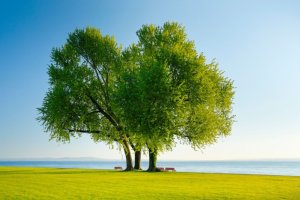
The rapid growth of silver maple trees is often a curse. It keeps the branches from growing thick. This fragility results in weak branches that can fall into strong winds.
Despite its shortcomings, it is an attractive collection with its vase shape. Its leaves appear green at the top, and silver underneath, and then turn pale yellow in the fall. The tree is a source of delicate flowers in early spring.
Care for silver maple trees is simple. It is tolerant of a broad variety of soil kinds. It will however grow more in more deep acidic, moist soil. It requires at least four hours of direct sunlight (full sun) that is unfiltered.
Other names that are commonly used: Creek maple, Silverleaf maple, Soft maple, Large maple Water maple Swamp maple White maple
Growing Zones: 3 – 9
Standard Size maturity: 50 – 80 feet with the spread being 35 to 50 feet
The Flowering Season: Early spring
13. Sweetbay Magnolia (Magnolia virginiana)
Landscapers in the south of the United States adore the charms of the evergreen sweetbay magnolia. They are also well-adapted to cold temperatures in certain regions of Wisconsin. It is possible to plant these trees in both the northern and Lake Michigan regions.
Sweetbay is a wonderful decoration tree. It is elegant with a vase or columnar shape. It is a great specimen tree or a tree for your patio.
In the months of May and June sweetbay magnolia produces creamy white flowers that measure about 2 to 3 inches in width. They have a lovely lemony scent. The tree is glistening with dark green leaves that have silver undersides. For maximum flowering, the tree requires the full sun.
This tree will prefer soil that is rich and moist. It will tolerate soil that is wet much better than dry ones. In the sense that it can withstand periodic flooding.
Sweetbay magnolia can grow from 13 inches up to 2 feet every year.
Other common names: Sweetbay, Laurel magnolia Swampbay, Swamp magnolia White bay Beaver tree
Growing Zones: 5 – 9
Average Size At Mature: 10 – 20 feet tall, with an equal spread
The Flowering Season: From late spring until early summer
14. Tulip Tree (Liriodendron tulipifera)
Tulips are a very popular tree that is native to the eastern part of North America. It grows at a rate of two feet every year.
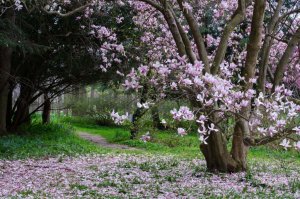
If you’re a wildlife enthusiast, you’ll be delighted to know that these gorgeous flowers add new life to your garden. They offer a valuable source of nectar to ruby-throated hummingbirds, which breed in Wisconsin as the trees bloom.
The Tulip Tree seeds develop in the summer and then remain on the tree through the winter. These seeds are food for many animals and birds.
The bright, vibrant green leaves are atop the aromatic stems. In autumn the leaves change into a bright golden-yellow hue.
Tulip trees love full sun. They thrive in acidic, clay loamy soils, which are moist, and sandy with well-drained soil. It also prefers regular humidity. But it is tolerant of droughts in Wisconsin due to the fact that Wisconsin has more humid conditions.
Other common names include: American tulip tree, Tuliptree, Tulip poplar, Whitewood, Fiddletree, Yellow-poplar
Growing Zones: 4 – 9
Average Size Mature: 70 – 90 feet tall, with an area of 40 feet
The Flowering Season: Late spring
15. White Pine (Pinus strobus)
This fast-growing pine tree originates from Wisconsin. With a growth rate of more than 2 feet per year, it creates an excellent evergreen screen or windbreak. White pine is a great nursery option because it’s simple to plant.
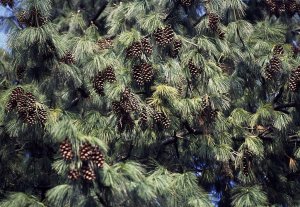
White pine is tolerant of humid, dry, acidic, and well-drained, soil. In comparison to other pine trees, they seem to be more apt to grow to thrive in moist soil. However, it is tolerant of every kind of environment including dry, rocky hills to bogs.
Be cautious if you have beavers, hares or rabbits, porcupines, or mice in your vicinity. They are fond of eating white pine bark which could cause harm to the pine.
Other names that are commonly used: Eastern white pine, Northern white pine, Weymouth pine, Soft pine
Growing Zones: 3 – 8
Standard Size Mature: 50 – 80 feet tall and 20-40 feet wide
16. Japanese Lilac tree
There are very few trees in this article that is good for small space. The Japanese Lilac Tree though is perfect for small and difficult spaces. You can control its size by pruning and maintaining it.
Almost all of the trees on this list are the foundation of your yard and land. The Japanese Tree Lilac though is the perfect accent for shrubs, bushes, flowers, and any other tree or plant in your yard.
The Japanese Lilac tree is the lowest-maintenance tree on this list. It doesn’t produce suckers, doesn’t need pruning, is not prone to insect infestations or diseases, and requires very little water.
Japanese Lilac trees require full sun. If you plant your Japanese Tree Lilac in the full shade there is a chance it will not grow as it should and as a young tree, it may potentially die.
This type of tree requires well-drained soil and loose soil. It does not tolerate clay nor does it do well in compact soil. If you plant your tree in anything but loose and well-drained soil there is a good chance it will not be able to properly grow.
The flowering season: Early Summer
Standard Size Mature: 15-25 ft
17. Elm Tree
Elm trees love heat making them one of the most versatile trees that you can grow almost anywhere in Wisconsin!
Like the other trees on this list, the elm tree is perfect for shade. It grows 40-50 feet tall, is incredibly wide, and perfect for anyone who wants an “old country” feel in their yard
Elm trees are the most disease-prone tree on this list. The Dutch Elm disease is destroying almost all of the trees in North America and is making it incredibly difficult to plant, grow, and protect your elm tree.
If the dutch elm disease wasn’t bad enough, elm trees are very prone to insects too! The number one insect that will destroy bark and leaves is the beetle. There are over 5 different types of beetles that will attack different parts of the tree.
Standard Size Mature: 40-50 ft
18. Crabapple Tree
Out of all the trees on this list, the crabapple tree is the best cross-pollinating tree. It should be planted near apple, pear, and cherry trees to help attract pollinators and encourage more fruit growth.
The Crabapple tree is the easiest tree on this list to grow. You can plant it anywhere in your yard, in any type of soil, in full sun or shade, and in any space.
All the trees on this list have pretty spring blooms, but none are as beautiful as the Crabapple Tree. This tree will not only have beautiful shades of white, pink, and red blooms, but it will also have the longest blooms all spring and sometimes even fall!
When it comes to Crabapple Trees there are very few if any things that can harm your crabapple trees. Old age is typically the only thing you have to worry about. When your crabapple tree gets older it is best to cut it down as it may attract harmful insects and pests to other trees by it.
Standard Size Mature: 15-20 ft
The Diversity of Fast Growing Trees for the Wisconsin Landscape
For those who are considering landscaping waiting for trees to develop can be daunting. However, it doesn’t have to be. The solution you require is a rapidly growing tree.
Eastern cottonwood and silver maple trees are amongst the fastest growing trees in North America on the above list. Most of the trees listed on this list are great shade trees including the northern red oak as well as American Sycamore. Ornamental tree, and have stunning flowers – sweetbay magnolia, northern catalpa, and sweet bay.
Of course, prior to you plant trees in a place you must be aware of the sun’s exposure and the type of soil. If you’re not cautious about these issues it is likely that even the most fast-growing trees won’t be able to live up to their name for speed.
